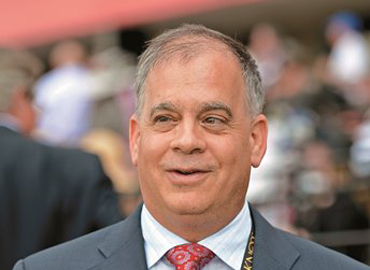By Bloodhorse.com
ARCADIA, Calif. (Dec. 22, 2018) — After months of frequent—and often abrupt—change at Santa Anita Park, Tim Ritvo is not content.
The chief operating officer of The Stronach Group, which owns the Southern California racetrack, says he will continue to seek change and try to make Santa Anita as profitable as possible, but for now things have settled down ahead of opening day Dec. 26.
“I can tell you there’s no more surprises. There’s no more surprises planned,” Ritvo said Dec. 20 from his office at the base of Santa Anita grandstand, in reference to recent removals of race caller Michael Wrona and racing secretary Rick Hammerle. “We’re going to do the best we can this meet, get a significant increase in field size—we hope—and add races if the inventory is there.”
While Ritvo didn’t speak directly about the personnel changes, he did say the process to replace Hammerle is close to being completed.
“We want to thank Rick for years of service, but the idea is to look for change, and we didn’t feel the direction we were going in was happening fast enough,” Ritvo said.
BALAN: Rick Hammerle Out as Santa Anita Racing Secretary
The aspect of quantity is a main plank in The Stronach Group’s business model, which it has profitably deployed at Gulfstream Park in Florida and Laurel Park in Maryland.
The more the better—more horses, more races, and more race dates.
The latter part of that list, as it relates to racing in California, will be an ongoing target of change for Ritvo, and he is unabashed. He wants more dates.
In Northern California, where The Stronach Group owns Golden Gate Fields, that involves taking dates from the region’s fair circuits, or at least gaining or exchanging desirable summer dates that the fairs have had a stranglehold on.
In Southern California, the target is also clear. The Stronach Group wants Los Alamitos Race Course‘s daytime racing dates.
In a scramble to adjust and compensate for the loss of racing and stables from Hollywood Park’s closure in 2013, Los Alamitos filled both voids quickly by expanding its racetrack and stable area in 2014 and was rewarded with a significant day rate to house many of the region’s Thoroughbreds (it is paid to house 850).
With the scramble now over and The Stronach Group seeking a greater role, as it did in a somewhat similar shift in Florida, Ritvo sees the daily payment to house horses at Los Alamitos (he says it’s about $12,000 a day) as wasteful compared with alternatives. He also feels the industry would benefit from not only stabling those horses at Santa Anita, but also running Los Alamitos’ allotted eight weeks per year at Santa Anita.
“I have the utmost respect for (Los Alamitos executive) Jack (Liebau) and (track owner Ed Allred), but the thing is, is Los Alamitos serving the industry as much as Santa Anita can serve the industry?” Ritvo said, identifying the decreased handle Los Alamitos experiences in comparison to Santa Anita and Del Mar, which notably have turf courses, while Los Alamitos does not. “On the brand alone—and we’ve proved this at Calder and Gulfstream—the same exact races run at Los Al, run at Santa Anita under the Santa Anita brand, could double pari-mutuel handle. We’ve run models where we’ve run our worst dates, and we’ve plugged in those numbers for the Los Al dates. What happened? The industry went from a $7 million purse pool to a $15 million purse pool.”
To solve the stabling hole, Ritvo has plans to add 850 stalls to the area that is currently a vast parking lot on the north end of the Santa Anita property. But to do that, he says Santa Anita needs to obtain Los Alamitos’ racing dates, which would fund the $35 million project. Ritvo said The Stronach Group is still working on acquiring the required permits for the project and indicated a once-proposed training center in nearby West Covina is “on hold.”
“When we talk about what’s in the best interest of the industry—everybody will think, ‘Oh, selfish Stronach, selfish Santa Anita,'” Ritvo said. “No. The truth of the matter is, in the best interest of the industry, those races should be run at Santa Anita under the Santa Anita brand, which sells better nationally than Los Alamitos does. Maybe one of the mistakes they made was not calling it Santa Anita West like we did at Gulfstream Park West. We went from (Calder) doing $1.6 million on average (daily handle) to doing $4 million on average, with pretty much the same people—same trainers, same jockeys.”
The wagering menu has also been a target of change at Santa Anita in recent months, and the newest effort has been labeled “horse racing roulette,” which would group horses in each race into three betting categories—red, black, and green. Ritvo said the idea came from the Las Vegas-based company Cantor Gaming, and the wager, at least in its early stages, is targeted at the “novice customer.”
“The target is definitely not the sophisticated wagerer,” Ritvo said. “The target is a new customer to make it simpler to churn and not get killed.”
Ritvo bristled a bit at the reaction the new wager received from vocal gamblers, mostly on social media, that a three-option wager with 15.43% takeout is poor value.
“The economic engine of this game is the sophisticated wagerer—the people who know how to bet. But at the same time, those people need new money in the pools,” Ritvo said. “They need liquidity. You need new money in the pool.
“If I’m a sophisticated wagerer, I should be going, ‘Oh, let me see how this works, and let me see if there’s a weakness in the model.’
“Let’s say I have a favorite restaurant, and all the sudden they add scallops on the menu. If I don’t eat scallops and they took something else off my menu, I’d be like, ‘What the heck? I’m stuck with scallops.’ But if they put scallops on the menu and don’t take anything off, I’m not going to go, ‘What the heck? I don’t eat this.’ I’m just not going to order it.”
Other new wagering ventures started in 2018—the Stronach 5, a Pick 5 wager that is spread across multiple Stronach-owned tracks, and the $0.20 jackpot Pick 6 at Santa Anita—are here to stay after trial periods.
The Stronach 5, which features a 12% takeout and runs on Fridays, has handled well since it began in September, and Ritvo lauded the days when the wager carried over, which led to negative-takeout payouts (the carryover total negated and exceeded the takeout from the main pool for that day). While Ritvo hasn’t resisted computer-based players with other wagers on The Stronach Group betting menus, he said the absence of those sophisticated algorithm players in the Stronach 5 pools also have led to larger-than-expected payouts.
“The Stronach 5 is another bet that the people who complain about takeout are missing the boat big-time,” he said. “It’s 12% takeout, and the computerized wagers haven’t been able to participate because they haven’t built a model for it. So it’s 100% real money. The reasons the payouts are so high is because we don’t have the computerized guys pounding it.”
And because of the setup of the wager, bettors playing the Stronach 5 will look at tracks they might not have considered playing before, which could have the extra benefit of inspiring handle on The Stronach Group tracks considered to be at a lower level than the “big leagues” at Santa Anita and Gulfstream.
“It’s here to stay, and we’ll continue to market it,” Ritvo said. “We’ve never done less than $100,000 (in handle) on it. Is it going to change anything from a revenue perspective? No. But it could (encourage wagering at tracks a bettor hasn’t considered in the past). We’re trying to take Laurel and Golden Gate into the big leagues with Santa Anita and Gulfstream. … You put eyeballs on your product.
“There’s a lot of product out there every day. Let’s say there’s 25 racetracks running at the same time. If you give them a chance to look at Golden Gate and Laurel, it makes all the sense in the world.”
Although it has become popular at several Stronach sites and at tracks outside of the group, the jackpot wager is one of the most criticized bets in the racing industry, because it essentially sequesters a portion of the daily pool (30% at Santa Anita) for the rare event of a single winning ticket. The jackpot is an appealing metaphorical carrot for a certain segment of bettors but is largely a fruitless pursuit for most, which changes the effective takeout of the wager significantly.
Ritvo contends the decreased minimum of the wager (20 cents instead of the traditional $2 Pick 6 minimum) opens the bet to a wider audience. He acknowledges the takeout concern but also lauds the payouts on a daily basis based on that minimum.
“When there’s 1,400 winners at a thousand dollars a piece, I actually like that, because it means 1,400 people went home and told their wife they hit the Pick 6,” Ritvo said. “They’re going to play again tomorrow. With the $2 Pick 6, you could literally go your whole lifetime without hitting it.
“We’re trying to make winners out of people with the 20-cent denomination.”
When presented with an option that would address the effective-takeout concerns, while still offering a more accessible wager to the general public (a more traditional Pick 6, without the jackpot provision but at a $0.20 minimum), Ritvo said, “That’s not off the table.”
So what’s next, other than Santa Anita’s quest for more racing dates?
Ritvo said instituting somewhat controversial “cashout wagers,” which would offer bettors with live multi-race wagers an option to “cash out” those bets for a guaranteed profit instead of risking a loss in later legs, is a future goal. He also indicated a desire to provide the betting public with more data, be it trifecta probables or jackpot Pick 6 will-pays, which are currently unavailable. More data on probable payouts would likely spur more wagering on any given race, Ritvo said.
But the underlying target to any initiative is continued growth (Santa Anita reported an 8% increase in all-sources handle during last season’s winter-spring meet), and the executive emphasized growth of the entire industry—not just The Stronach Group—although he acknowledged one of the organization’s most common criticisms is that it only looks out for its own interests.
“You want to see your market share increase, but if we’re just stealing it from another track or even our own entity, you’d really like to see the industry grow,” Ritvo said. “And nobody has figured out how to do that. The Stronach Group is outperforming the industry. I can show you all the data. But that doesn’t make us really proud—stealing business from Delaware or Philadelphia.
“Our first goal is to make people bet on us because we offer a quality product, but it would be nice to grow the industry. But we need those tracks to be in business. Rising waters lift all boats.”


